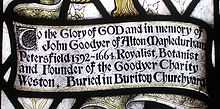John Goodyer

John Goodyer (1592–1664) was a 17th-century botanist who lived in Hampshire, England. He was born in Alton, and evidently received a good education, although it is not known where. He worked as estate manager to Sir Thomas Bilson, of West Mapledurham House (demolished 1829), near Buriton, and also as agent for two Bishops of Winchester: Thomas Bilson (father of Sir Thomas Bilson) and later, Lancelot Andrewes. Goodyer resided in the village of Droxford until his marriage in 1632, when he moved to Petersfield, where his house on The Spain still stands.[1]
Goodyer developed a great interest in botany, and added many plants to the British flora. He is credited with clarifying the identities of the British elms, and for discovering an unusual elm endemic to the Hampshire coast between Lymington and Christchurch named for him as Goodyer's Elm, believed to be a form of the Cornish Elm. Goodyer gained the reputation of being "the ablest Herbalist now living in England". He is also believed to have introduced the Jerusalem Artichoke to English cuisine, but perhaps his most enduring legacy was his revision, with Thomas Johnson, of Gerard's Herbal, the greatest herbal of its time.[2] He also translated a Latin version of Dioscorides's work, 'De Materia Medica'.[3] Indeed, Goodyer's reputation was such that in 1643 during the English Civil War, Ralph Hopton, one of the senior Royalist commanders, ordered troops "to defend and protect John Goodyer, his house, family, servants and estates".

Goodyer lies in an unmarked grave near his wife's at St Mary’s church, Buriton, where a stained glass window can be found as a memorial to him, showing the Goodyer coat of arms. With no children to succeed him, the majority of his estate passed to his nephew, the Reverend Edmund Yalden, but proceeds from the residue were used to establish the John Goodyer Charity to help the poor of Weston, a hamlet near Buriton; the charity still exists today. His works and books are now stored at Magdalen College, Oxford, and in recognition of his industry, Goodyera, a genus of small terrestrial orchids, has been named for him.[4]
References
- ↑ "Petersfield Museum - History". Retrieved 20 September 2014.
- ↑ Hoeniger, F.D. & J.F.M. (1969). Growth of Natural History in Stuart England: From Gerard to the Royal Society. Associated University Presses. ISBN 978-0-918016-14-0.
- ↑ Pavord, A (2005). The Naming of Names: The Search for Order in the World of Plants. Bloomsbury. ISBN 978-0-7475-7952-6.
- ↑ "Buriton Heritage Bank (2001) Information Sheet No. 5: Local luminaries – famous people from the area".
- ↑ "Author Query for 'Goodyer'". International Plant Names Index.
|